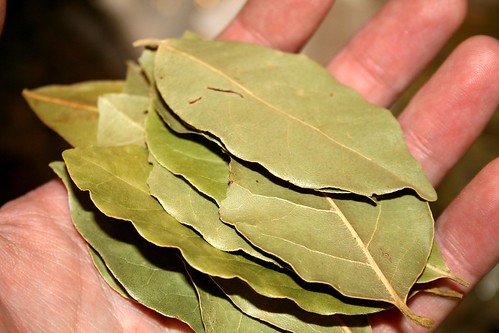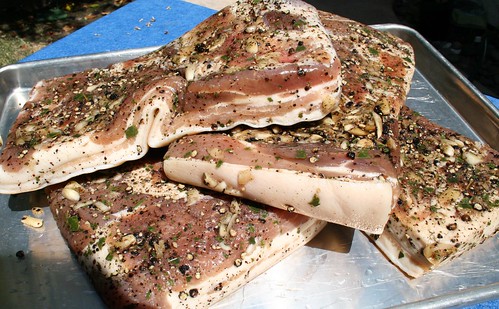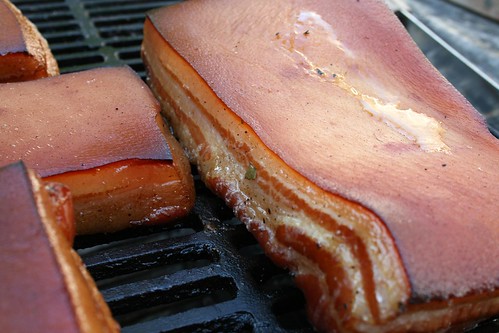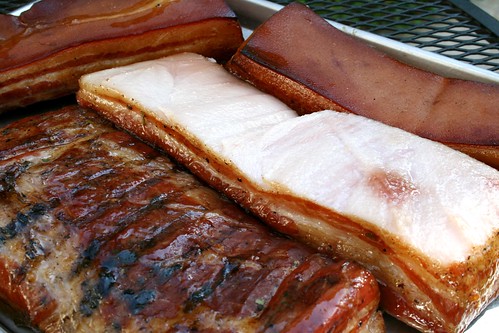
You know how delicious bacon is? It makes everything else better. There's almost nothing better than bacon. Except homemade bacon. As a comparison: store-bought bacon is to tofu as homemade bacon is to store-bought bacon. Yes, homemade bacon is that good. It's meatier, more flavourful, smokier and all-round more delicious. And if you have a charcoal grill, it's really easy to make. All you need is a pork belly, and a few items to cure with. I get my pork belly at my local butcher, or at the neighborhood Asian grocer.
I use the recipe from Charcuterie . You'll need a couple things that aren't available at your neighborhood grocery. Thankfully, everything you need is cheap and available online.
. You'll need a couple things that aren't available at your neighborhood grocery. Thankfully, everything you need is cheap and available online.
Start by making a basic dry cure:
1 pound kosher salt13 oz dextrose3 oz pink salt (also called InstaCure #1, at Sausagemakers)
Now, you make the seasoning blend. Start with something tasty, like bay leaves.

For each pork belly [edit: 3-4 lb pork belly], grind up:
3 bay leaves1 tbsp black peppercorn

Grind 'em into a nice coarse mix. Mix them with:
¼ cup dry cure (from above)
5 chopped garlic cloves

Wash the pork belly, dry it off, and rub it all over with the seasoned dry cure.
Place the belly in a ziploc bag, squeeze out all the air, seal, and put it in the fridge. You'll cure it in the fridge for about a week. Every few days, open it up and pour off any extra liquid that accumulates. The salt pulls out a fair amount of water, so don't be surprised to see the liquid accumulate, and the meat firm up. After 7 to 8 days, you'll be ready to smoke.

Rinse off the spice and cure in the sink, and pat the pork belly dry.

While the pork belly comes to room temperature (for half an hour or so), fire up your grill for indirect heat. I light a small fire on one side of the grill, and put the cured pork bellies on the other side. You'll want a bbq fire around 200°F, and some wet hickory wood to make a little smoke. Lay the belly down skin side up.



Keep in mind, this meat is not cooked. It's not ready to be eaten. Treat this like raw bacon from your grocery store (only more precious - treat it like it's bacon you paid $30 a pound for).
While it's still hot, slice the skin off. I like to use a pair of tongs to hold the skin up while I gently slice it off. It'll end up looking like this:

The belly on the left is showing the side that was facing the grill. The second belly is after the skin has been sliced off the top, and the third one is the smoked belly with the skin still on.
Let the belly's come down to room temperature, at this point either wrap them and freeze or refrigerate them. When you're ready to serve them, slice them thinly on the cross section. This is the only tricky part, slicing them thin enough to get nice-sized bacon slices that are thin enough to render the fat properly. The last inch of belly can be chopped into lardons or bacon bits for serving on salads or in sauces. But you richly deserve something delicious. Fry and serve.



7 comments:
mmmmm, bacon.
this looks astonishingly tasty. I am dreaming of living somewhere big enough for a backyard and grill now.
*: Yep, mmmmm...
m: Yeah, having a backyard is pretty nice. We only got one a few years ago, and I've been smoking/grilling/bbqing up a storm ever since. It would be hard to go back to apartment living again...
Great demonstration. However, if you do hot smoke your bacon to an internal temperature of 150, then this is definitely safely cooked pork at that point and can be eaten as is. Of course, it also benefits from further frying in the pan (slowly, so that it starts cooking in its own rendered fat).
njmarkovich,
Is it really safe at 150? It certainly doesn't look "cooked" at 150. I haven't tasted it before frying it, but it certainly *looks* more delicious after frying...
Yeah, it will still look light pink, due to the sodium nitrite (or "Instacure #1"/"Prague Powder #1"). The curing salt preserves the pink color in meat when cooked, among its other benefits. Same case with things like simmered corned beef or a grilled kielbasa. But my comment was somewhat pointless since it's better fried up afterwards, anyways. I've been going through a pork belly kick lately, which often leads me to perusing pictures of food on Google Images--which is how I came across this. These are really great pictures--I'll have to check out some of your other projects. Have you tried the pancetta or guanciale recipes out of "Charcuterie?" Good stuff.
Haven't done either pancetta or guanciale yet. I think it might be too dry/too warm in southern California to do pancetta without some kind of curing fridge, and as yet I don't have one. I'd sure like to try it though.
Post a Comment